A Festival of Border History: the Carlisle Pageant, 1951.
Let's have another pageant!
Of the three pageants held in Carlisle, the 1951 event was far and away the largest. The grandstand erected at Bitts Park to house the audience for a rerun of the city's pageant, first staged in 1928, accommodated 3000 people. Across all of the twelve performances held during the first two weeks of August (which included six dress rehearsals where invited audiences came along), an incredible 120,000 people saw the show. This number included local Cumbrians and visitors from other parts of Britain - both north and south of the Border - as well as overseas tourists who diverted their pilgrimages to the Lake District and came north to England's Border city especially to take in its pageant.
By all accounts, none who arrived was disappointed by what they saw. Having said which, most were not accommodated in the covered grandstand but stood throughout. For two shillings and sixpence, a standing ticket allowed an adult entry to this spectacle; and though a person might be a bit footsore after three hours, the time seemed to fly by - just as the centuries did in the pageant! Hardly a drop of rain fell during the event, and the 1951 Carlisle pageant emerged as sell-out show.
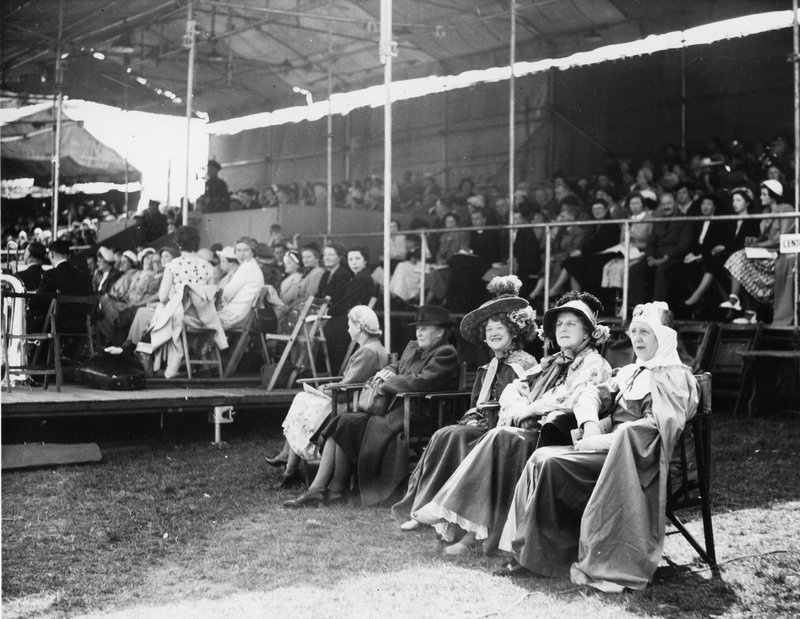
Like most outdoor pageants in this period, Carlisle’s provided a covered grandstand, which could be a godsend if the weather proved inclement. As we can see in this photo, the stand was packed. However, the vast majority of spectators took the cheaper, though riskier option to stand in the open to watch the pageant. Fortunately, in 1951 the weather was on their side! Here we also see some performers seated. This is unusual as performers generally had to move rapidly offstage where they saw nothing of the action. It is unlikely that they were waiting to go on; generally actors were kept well out of sight until their moment in the limelight however, this photo may have been taken at a dress rehearsal.
The Secret of Pageant Success.
How had Carlisle managed to pull off such success again, when the city was still recovering from long years of wartime heartache and privations? Enthusiasm for the task and a keen awareness of the city's earlier pageant triumph in 1928 seems to be the answer. The Festival of Britain, which was on-going in 1951, gave rise to a number of pageants across the UK; and in Carlisle, when it came to choosing the city's own contribution to this nationwide extravaganza, a historical pageant was the obvious choice. When the city held its first pageant during the interwar years, this event had been the largest collective endeavour Carlisle had ever seen (well, if we exclude times of Border discord!) so when it came to bringing citizens together again in 1951, another pageant was the obvious choice. Both pageants took place in tandem with a 'Civic Week' meant to showcase Carlisle's local economy, society and culture; but in each case, the pageant turned into the unchallenged highlight of the whole week.
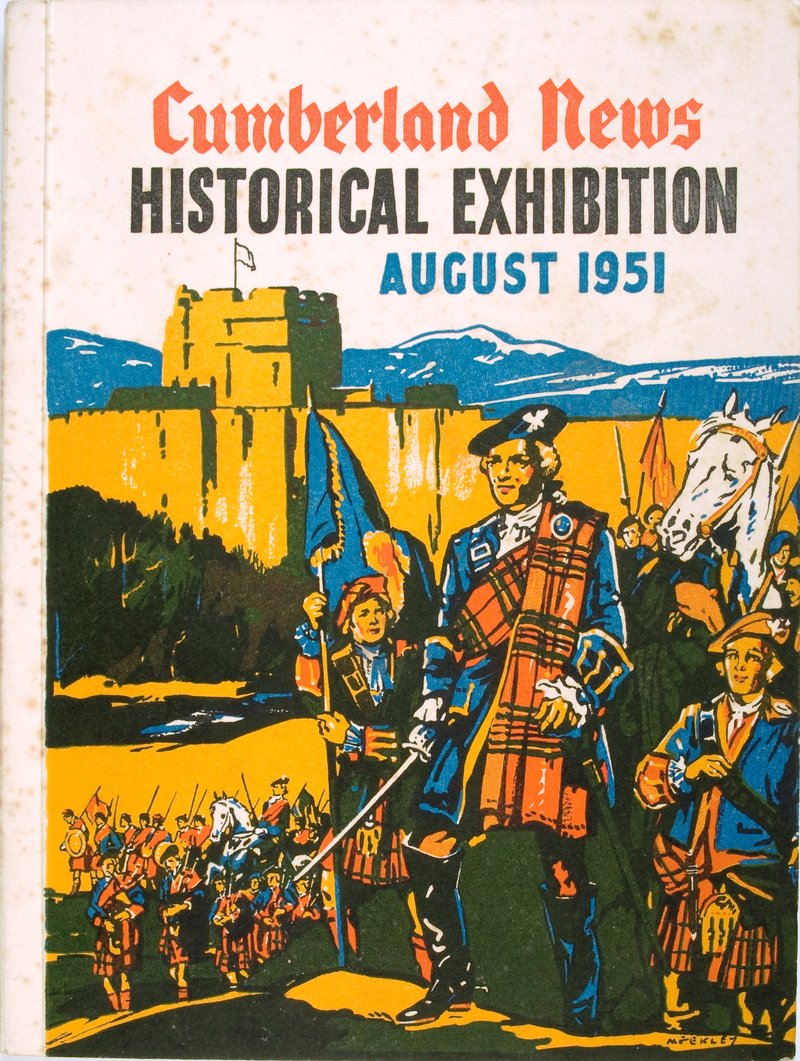
The Civic Week in Carlisle in 1951 included a packed programme of attractions including a historical exhibition held at Tullie House Museum. This programme for the exhibition sponsored by the local press, features Bonnie Prince Charlie and his Jacobite army on its cover. Due to paper rationing, much of the literature produced in association with Carlisle's Civic Week was not very glossy; however, this colour image was an exception.
Bigger and Better Than Before.
While 4000 citizens had taken part in 1928, in Festival year this number was increased to an amazing 5000 performers drawn from a variety of different community groups. Congregations of local parishes, schoolteachers from across the city, amateur dramatic societies and choirs, dance schools, Boy Scouts, women's associations and so forth, plus, inevitably, the locally-based Border Regiment: once again all came together with the attitude that hail, rain or shine - the show would go on! It was estimated that a likely 1 in 20 of the city’s total population played some part in the pageant either as an organiser or performer (or in some case both).
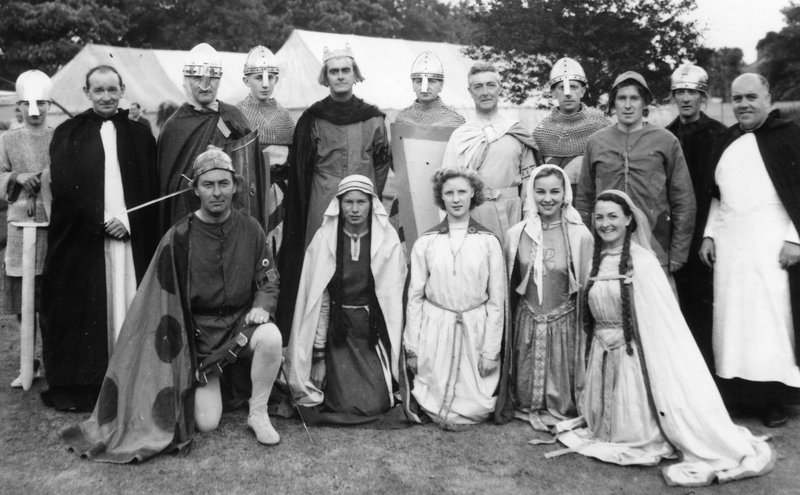
These performers from episode IV, which featured the Norman Kings in Carlisle, were all schoolteachers. Situated 5th from the right in the back row is Mr William Eite who played William Le Meshyn in both 1928 and 1951. His daughter, kneeling on the far right, was also a teacher in a local school and played a lady in waiting.
Although offered as a contribution to a countrywide celebration, the pageant in 1951 was an intensely local affair because Carlisle folk really did feel that they owned this event. No changes were made to the 1928 script and even the pageant master appointed this time round, was a local man: Lionel Lightfoot was a solicitor by trade, but a thespian by inclination. He was very active in amateur theatre and headed a local dramatic group who put on many performances at the city's Her Majesty's Theatre. Lightfoot, who had received an OBE for his work, had been involved with the 1928 pageant and was the obvious choice for the job. Indeed, many of the people who came forward to take on the role of pageanteer in 1951 had also taken part in 1928. This time around too, pageant old-timers often encouraged their children to get on board.
Just as the programme remained unchanged, the music was also the same as that played at the earlier pageant; and once again the musical arrangements and the conducting of the orchestra was left to the Director of Music at Carlisle Cathedral, Dr F. W. Wadely who was by then a very well known figure in the city.
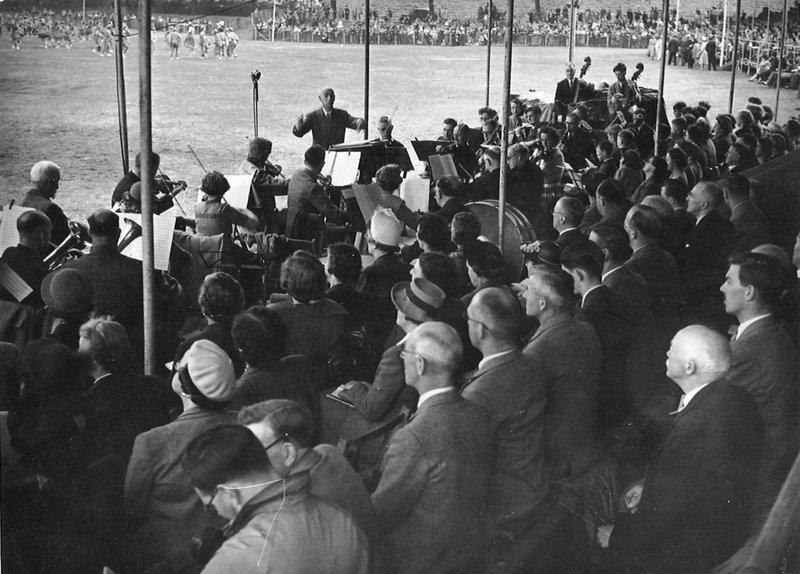
Dr Wadely had been Musical Director in 1928 and was still in his post at the Cathedral in 1951. For both pageants, the musical composition used was mostly his, but some traditional pieces were also included such as ‘Charlie Is My Darling’ played during the Jacobite episode with a new arrangement done by Wadely. Musical accompaniment included a 100 piece orchestra and a large choir
Although this simple rerun of an earlier success - without any modernisation or acknowledgement that popular tastes just might have changed - may all seem a bit ‘make do and mend’, the fact was that the 1928 show was so fondly remembered by Carlisle’s citizens, that altering it would have been unthinkable. And of course, the city could and did exploit this goodwill to ensure second-time round success. A lot of hard work by a lot of people was involved, thankfully, their efforts paid off.
A prologue, nine episodes, an epilogue and a royal visitor.
The running order of the pageant was as follows:
The Prologue (delivered by Father Time)
Episode I: Hadrian and the Roman wall (set in A.D. 122)
Episode II: King Arthur and the Picts (set in A.D. 500) Ep
Episode III: St. Cuthbert (set in A.D.685 - 875)
Episode IV: Carlisle and the Norman Kings (two scenes set in 1092 & 1132)
Episode V: King Edward I (set in 1307)
Episode VI: Mary Queen of Scots (set in 1568)
Episode VII: Kinmont Willie (set in 1596)
Episode VIII: The '45 (set in 1745 of course!)
Episode IX: Carlisle and Gretna Green (set around 1797)
The Epilogue, Grand Tableau, and March Past of all the performers.
The themes which ran through the
pageant were the perils of life in a border settlement and the fractious
relationship between Cumbrians and Scots over centuries. The pageant programme
summed up this aspect of local history as characterised by ‘constant scrapping
on the Border’.1 Humour was used to downplay such tensions in
the past within, for example, the Jacobite episode wherein the tragedy of the 1745
cause was just as integral to the drama as the ascendancy of the Hanoverians;
and a romantic sub-plot ran through episode VIII which featured the infamous Scottish
Border Reiver, Kinmont Willie - this narrative diversion leavened any possible
criticism being attributed to either side in the unfolding of this tale.
Yet, though heavily focussed on local heroes and anti-heroes, the pageant did celebrate British national identity; and the inevitable ascendance of British institutions underpinned the narrative as a whole. In general, the message delivered was that whatever happened in the past had all been made good when the Scots and English decided to come together. Highlighting this theme, the pageant was also graced with a royal visit. Princess Margaret – then the darling of the British press – arrived as a special guest of the city’s Civic Week.
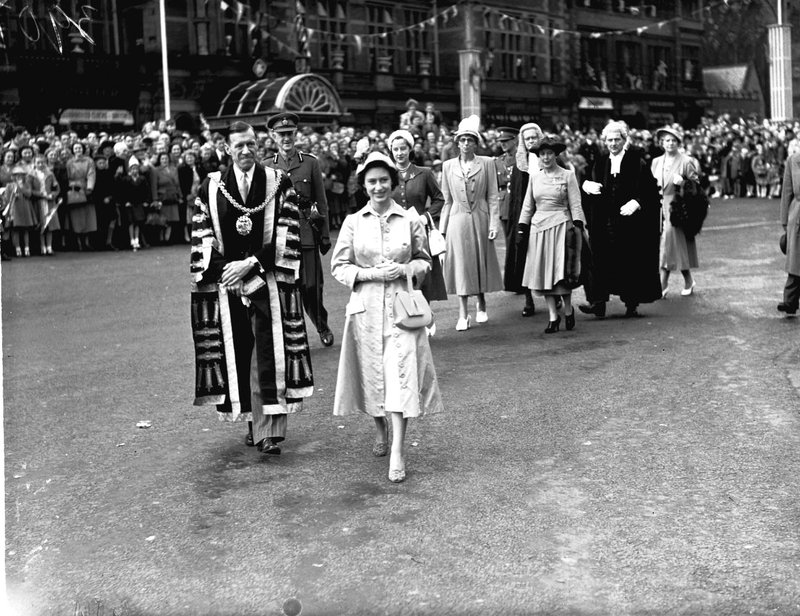
The Princess attended the Civic Week in Carlisle just before her 21st birthday when discussion about her love life and her fashion choices had reached fever pitch in the British press. Her arrival in Carlisle attracted huge crowds on well wishers and brought attention to the city’s festivities.
On Wednesday of pageant week, the Princess made an official visit to the Industrial Exhibition held in the covered market, had lunch with the Mayor in the Crown and Mitre Hotel on English Street, then ended the day by taking in the pageant. This created a great stirring of patriotic support for the royal family within the local press; and despite all the shenanigans of Jacobites and Border Reivers within the pageant, her appearance did much to augment the palpable atmosphere of British national pride that accompanied the event and enveloped the city.
As an article in the local daily paper proudly made clear on the day of Princess Margaret’s visit:
The great houses of the North and those of the Scottish Borders have contributed to the fabric which is our Cumberland story. The young Princess, with the blood of England and Scotland in her veins, cannot but be stirred by the story which we unfold... We are a Border City, but now living at peace with our neighbours. Our guest today represents our Royal House under whose Crown we all, Scots and English combined, are proud to serve.2
With World War 2 behind them but still in very recent memory, such a call to harmony may well have had special resonance for many who read these words.
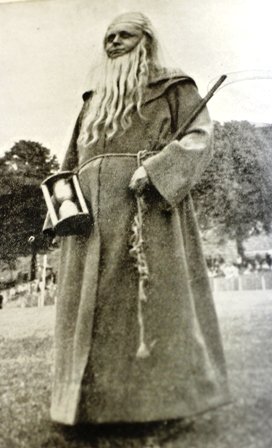
In 1928, Father Time had been a stately figure dressed in graceful,
Grecian-inspired garb. In 1951 he had somewhat more rustic appearance.
The epilogue at the Carlisle pageant was a feat of amazing choreography and must have been a spectacular sight to witness as 5000 people marched onto the arena, processed around it, and then left again. During this grand finale, Time’s torch was handed to a representative of each episode before being given back again to Time: an exercise that likely required impeccable timing. At the end, only Father Time was left on the pageant field where he was joined by ‘a child of today’ who looked up into the old man’s face ‘with an unspoken question’ before being led offstage by the venerable Time.3 If this sounds a little gloomy, that would be a very wrong impression to give.
Local and National, Past and Present- All Intertwined.
The 1951 Carlisle Civic Week and historical pageant aimed to create a carnival atmosphere and succeeded in doing so. The programme for the weeklong festival included some late night revels. While the likes of the Industrial Exhibition hoped to drum up business and the pageant aimed to educate and entertain, with so many people coming out of their homes to have a good time, and visitors thronging the city, there were also opportunities just to have fun. In episode IX of the pageant, the ancient Carlisle Fair was re-enacted, and in 1951 every effort was made to bring about the same light-hearted and optimistic mood which was a feature of this scene. After the performance finished, evening entertainments on the pageant ground were every bit as well attended as the pageant itself, with traditional singsongs and presentations of country dancing (representing both sides of the Border) as well as military tattoos and firework displays, all bringing in the crowds. In these shows, traditional pastimes were presented as still relevant and as a welcome addition within modern life.
The huge popular response that the pageant promoted within this relatively small British city is testament to the continued appeal of historical pageantry even after the disruption of the war and the rapid social change that this is alleged to have wrought throughout Britain. Indeed, the lure of the past and celebration of history may have been even more potent at this time when in very recent memory national security had been so nearly breached; and any self-assuredness that Britannia would continue to rule was definitely a matter for greater doubt. Yet for most people who took part in the pageant, or came along to see it, such anxieties were hardly uppermost in their minds – their thoughts were most likely all about having a jolly good time!
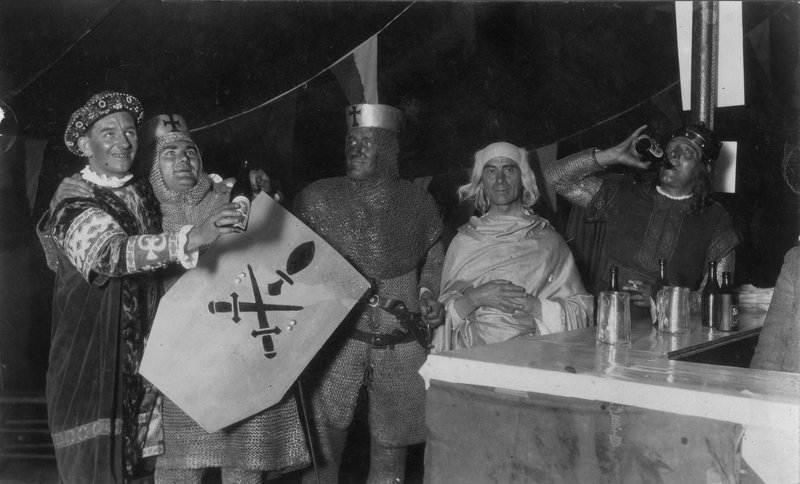
This image indicates that a refreshment stall which sold alcohol was provided backstage for performers who look to be having a good time after their moment in the limelight – or perhaps before, we do not know!
The general feeling of good times was summed up by one pageant performer, Ken Ogilvie, at the time only 18-years old. Initially Ken had not especially looked forward to the pageant; it came along when he was busy with his studies, looking forward to his exams finishing, to the end of school, and - as an outdoor enthusiast - to a fortnight away with his Scout Troop that had been planned for the end of term. He was soon to change his mind. Following his final performance in the role of Bonnie Prince Charlie he wrote in his diary that ‘it seems impossible that it has ended. It was all one glorious, lovely successful dream’.4
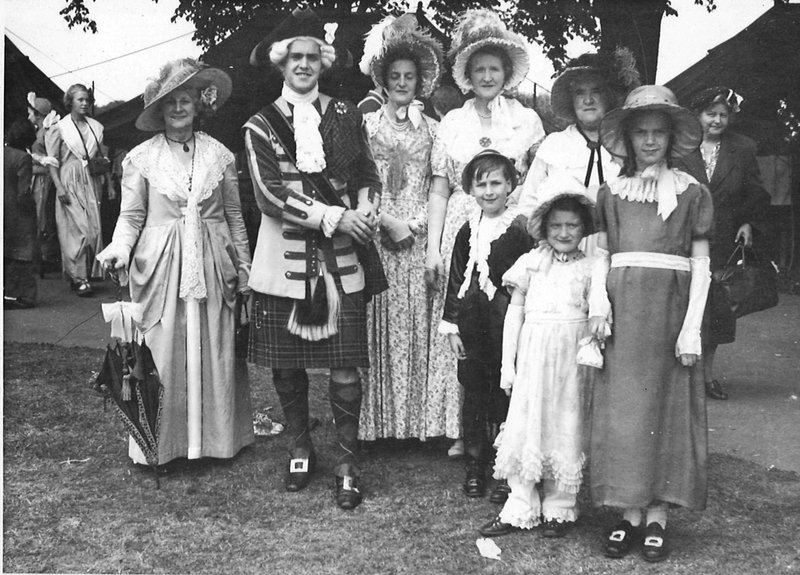
Ken Ogilvie was a member of Carlisle Grammar School’s Scout Troop. He and his fellow Scouts took on the roles of Jacobites in the pageant. They were much feted during the event with members of the public as well as other performers wanting their photo taken alongside these ill-fated but still romantic and glamorous figures from the past. Ken’s diary reveals that after acting in the pageant he and his pals saw many of the evening entertainments. Image reproduced with the kind permission of Mr Ken Ogilvie.
Yet the dream did not die in Carlisle. The 1951 pageant may have been only one of many that took place in this Festival year, but it had a lasting local legacy, not just in personal memory for performers such as Ken, but in local collective memory – it was with this event that a new local tradition was made in Carlisle ensuring that pageantry would return to this city.
Read more about the 1951 pageant on this site at The Historical Pageants of Carlisle
Over the coming weeks more information about the Carlisle pageants will be added. If you have memories of these events please get in touch by clicking here: GET INVOLVED We would love to hear from you!
1 The Carlisle Historical Pageant, August 6-11, 1951, Price 2s. 6d. – Souvenir Programme, 20 (Carlisle, 1951).
2 ‘Large Crowds Greet the Princess’, Cumberland Evening News, 8 August 1951, 3.
3 The Carlisle Historical Pageant, August 6-11, 1951, Price 2s. 6d. – Souvenir Programme, 25 (Carlisle, 1951).m
4 Mr Ken Ogilvie has generously donated many pageant images from his own collection as well as extracts from his diary written during this time and an oral history interview. The Redress of the Past project wishes to acknowledge his invaluable contributions.
